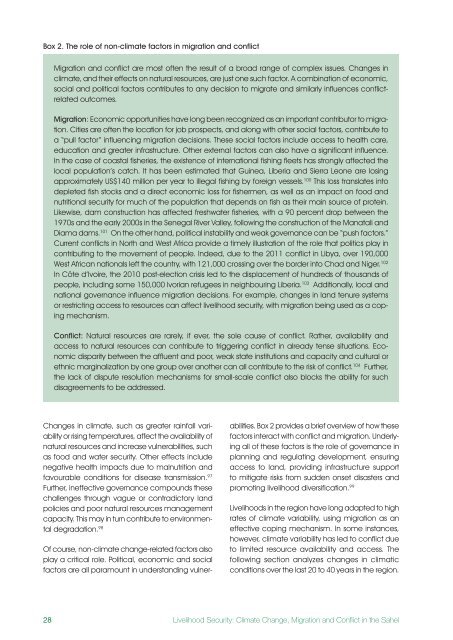Livelihood Security: Climate change, conflict and migration in - UNEP
Livelihood Security: Climate change, conflict and migration in - UNEP
Livelihood Security: Climate change, conflict and migration in - UNEP
You also want an ePaper? Increase the reach of your titles
YUMPU automatically turns print PDFs into web optimized ePapers that Google loves.
Box 2 . The role of non-climate factors <strong>in</strong> <strong>migration</strong> <strong>and</strong> <strong>conflict</strong><br />
28<br />
Migration <strong>and</strong> <strong>conflict</strong> are most often the result of a broad range of complex issues. Changes <strong>in</strong><br />
climate, <strong>and</strong> their effects on natural resources, are just one such factor. A comb<strong>in</strong>ation of economic,<br />
social <strong>and</strong> political factors contributes to any decision to migrate <strong>and</strong> similarly <strong>in</strong>fluences <strong>conflict</strong>related<br />
outcomes.<br />
Migration: Economic opportunities have long been recognized as an important contributor to <strong>migration</strong>.<br />
Cities are often the location for job prospects, <strong>and</strong> along with other social factors, contribute to<br />
a “pull factor” <strong>in</strong>fluenc<strong>in</strong>g <strong>migration</strong> decisions. These social factors <strong>in</strong>clude access to health care,<br />
education <strong>and</strong> greater <strong>in</strong>frastructure. Other external factors can also have a significant <strong>in</strong>fluence.<br />
In the case of coastal fisheries, the existence of <strong>in</strong>ternational fish<strong>in</strong>g fleets has strongly affected the<br />
local population’s catch. It has been estimated that Gu<strong>in</strong>ea, Liberia <strong>and</strong> Sierra Leone are los<strong>in</strong>g<br />
approximately US$140 million per year to illegal fish<strong>in</strong>g by foreign vessels. 100 This loss translates <strong>in</strong>to<br />
depleted fish stocks <strong>and</strong> a direct economic loss for fishermen, as well as an impact on food <strong>and</strong><br />
nutritional security for much of the population that depends on fish as their ma<strong>in</strong> source of prote<strong>in</strong>.<br />
Likewise, dam construction has affected freshwater fisheries, with a 90 percent drop between the<br />
1970s <strong>and</strong> the early 2000s <strong>in</strong> the Senegal River Valley, follow<strong>in</strong>g the construction of the Manatali <strong>and</strong><br />
Diama dams. 101 On the other h<strong>and</strong>, political <strong>in</strong>stability <strong>and</strong> weak governance can be “push factors.”<br />
Current <strong>conflict</strong>s <strong>in</strong> North <strong>and</strong> West Africa provide a timely illustration of the role that politics play <strong>in</strong><br />
contribut<strong>in</strong>g to the movement of people. Indeed, due to the 2011 <strong>conflict</strong> <strong>in</strong> Libya, over 190,000<br />
West African nationals left the country, with 121,000 cross<strong>in</strong>g over the border <strong>in</strong>to Chad <strong>and</strong> Niger. 102<br />
In Côte d’Ivoire, the 2010 post-election crisis led to the displacement of hundreds of thous<strong>and</strong>s of<br />
people, <strong>in</strong>clud<strong>in</strong>g some 150,000 Ivorian refugees <strong>in</strong> neighbour<strong>in</strong>g Liberia. 103 Additionally, local <strong>and</strong><br />
national governance <strong>in</strong>fluence <strong>migration</strong> decisions. For example, <strong>change</strong>s <strong>in</strong> l<strong>and</strong> tenure systems<br />
or restrict<strong>in</strong>g access to resources can affect livelihood security, with <strong>migration</strong> be<strong>in</strong>g used as a cop<strong>in</strong>g<br />
mechanism.<br />
Conflict: Natural resources are rarely, if ever, the sole cause of <strong>conflict</strong>. Rather, availability <strong>and</strong><br />
access to natural resources can contribute to trigger<strong>in</strong>g <strong>conflict</strong> <strong>in</strong> already tense situations. Economic<br />
disparity between the affluent <strong>and</strong> poor, weak state <strong>in</strong>stitutions <strong>and</strong> capacity <strong>and</strong> cultural or<br />
ethnic marg<strong>in</strong>alization by one group over another can all contribute to the risk of <strong>conflict</strong>. 104 Further,<br />
the lack of dispute resolution mechanisms for small-scale <strong>conflict</strong> also blocks the ability for such<br />
disagreements to be addressed.<br />
Changes <strong>in</strong> climate, such as greater ra<strong>in</strong>fall variability<br />
or ris<strong>in</strong>g temperatures, affect the availability of<br />
natural resources <strong>and</strong> <strong>in</strong>crease vulnerabilities, such<br />
as food <strong>and</strong> water security. Other effects <strong>in</strong>clude<br />
negative health impacts due to malnutrition <strong>and</strong><br />
favourable conditions for disease transmission. 97<br />
Further, <strong>in</strong>effective governance compounds these<br />
challenges through vague or contradictory l<strong>and</strong><br />
policies <strong>and</strong> poor natural resources management<br />
capacity. This may <strong>in</strong> turn contribute to environmental<br />
degradation. 98<br />
Of course, non-climate <strong>change</strong>-related factors also<br />
play a critical role. Political, economic <strong>and</strong> social<br />
factors are all paramount <strong>in</strong> underst<strong>and</strong><strong>in</strong>g vulner-<br />
abilities. Box 2 provides a brief overview of how these<br />
factors <strong>in</strong>teract with <strong>conflict</strong> <strong>and</strong> <strong>migration</strong>. Underly<strong>in</strong>g<br />
all of these factors is the role of governance <strong>in</strong><br />
plann<strong>in</strong>g <strong>and</strong> regulat<strong>in</strong>g development, ensur<strong>in</strong>g<br />
access to l<strong>and</strong>, provid<strong>in</strong>g <strong>in</strong>frastructure support<br />
to mitigate risks from sudden onset disasters <strong>and</strong><br />
promot<strong>in</strong>g livelihood diversification. 99<br />
<strong>Livelihood</strong>s <strong>in</strong> the region have long adapted to high<br />
rates of climate variability, us<strong>in</strong>g <strong>migration</strong> as an<br />
effective cop<strong>in</strong>g mechanism. In some <strong>in</strong>stances,<br />
however, climate variability has led to <strong>conflict</strong> due<br />
to limited resource availability <strong>and</strong> access. The<br />
follow<strong>in</strong>g section analyzes <strong>change</strong>s <strong>in</strong> climatic<br />
conditions over the last 20 to 40 years <strong>in</strong> the region.<br />
<strong>Livelihood</strong> <strong>Security</strong>: <strong>Climate</strong> Change, Migration <strong>and</strong> Conflict <strong>in</strong> the Sahel

















